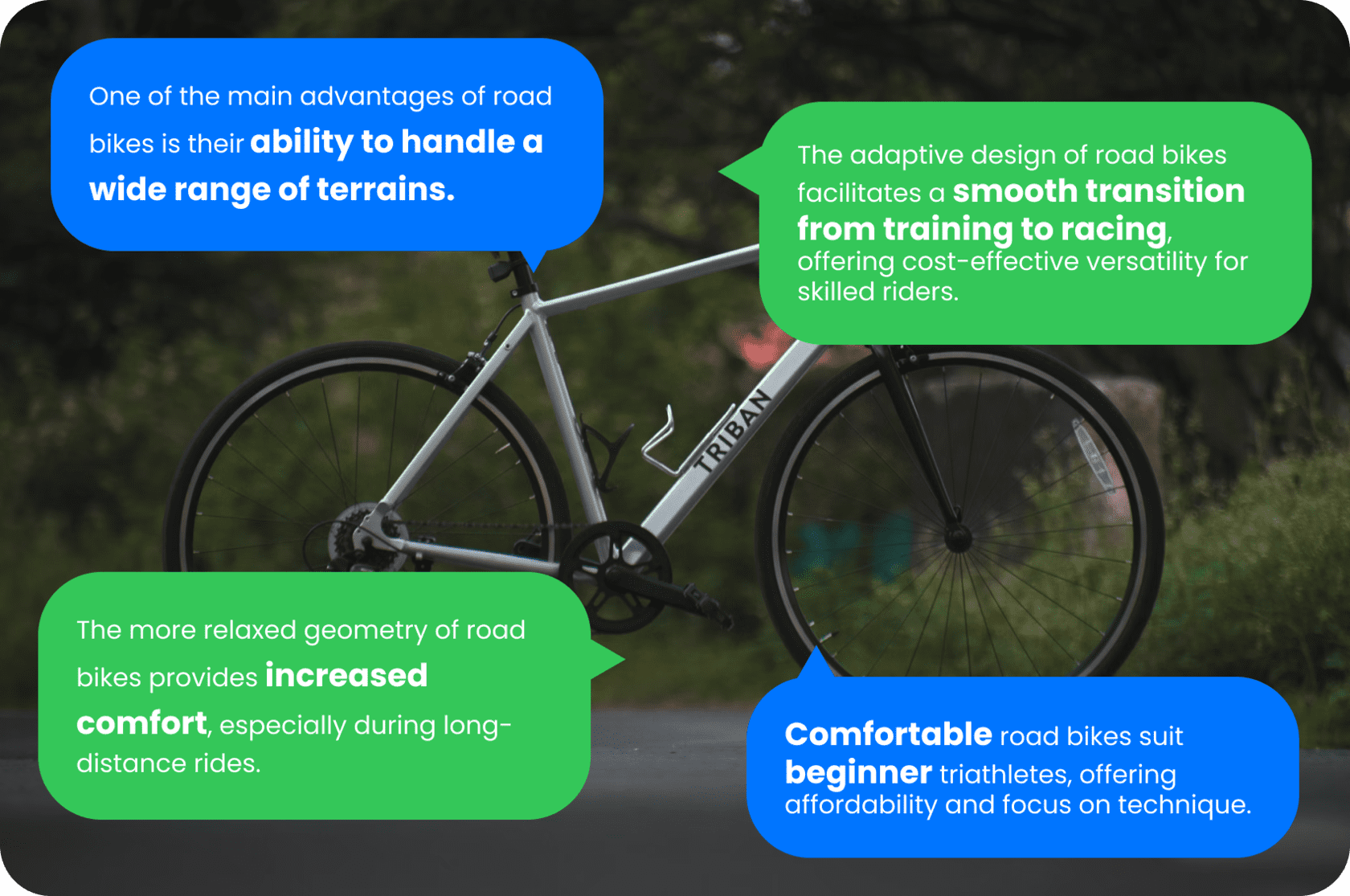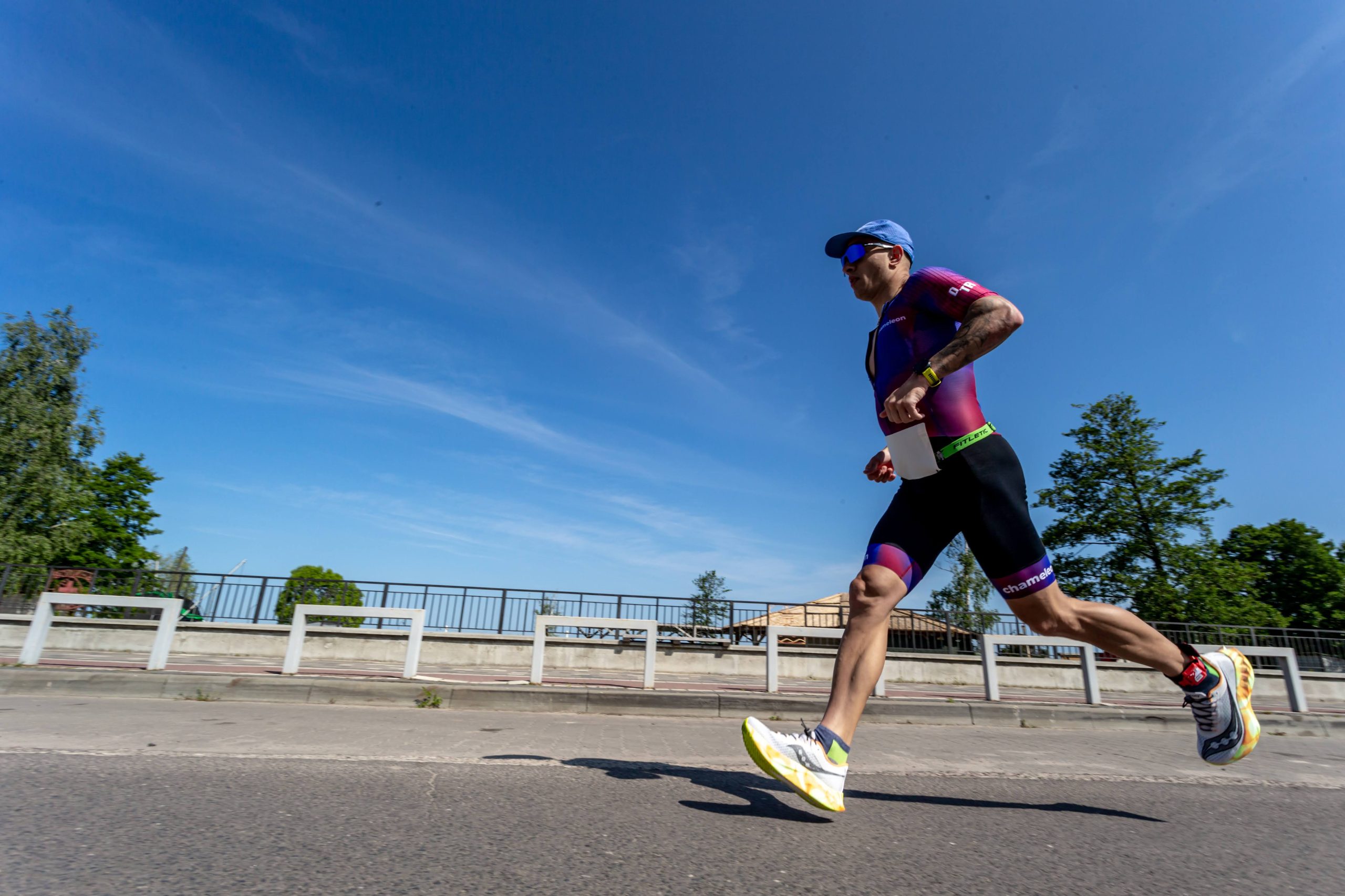Selecting the perfect triathlon bike is akin to choosing a trusty companion on your journey to victory.
In this article, we embark on a meticulous exploration of the three fundamental types of tri bikes: road bikes, time trial bikes (TT), and specialized triathlon bikes.
By understanding the nuances of each type, we aim to empower athletes to make an informed decision that aligns with their unique goals, preferences, and aspirations.
Road Bike
A traditional road bike, often considered the quintessential all-rounder of the cycling world, is a purpose-built machine that straddle the domains of performance, endurance, and versatility.
In the context of triathlons, road bikes shine as the go-to choice for athletes seeking a well-rounded option that can seamlessly transition from training sessions to race day.
Road Bike Features
Versatility reigns as a defining characteristic of road bikes.
With their adaptable geometry, road bikes boast drop handlebars that facilitate multiple hand positions, allowing riders to shift effortlessly between upright cruising and aerodynamic positions.
This flexibility translates to enhanced comfort over long distances, making road bikes a stalwart companion for triathletes who embrace the spectrum of endurance challenges.
Furthermore, the endurance-oriented design of road bikes for triathlon prioritizes a more relaxed riding posture, reducing strain on the body during extended rides.
Imagine a road bike as your trusty steed, gliding through a diverse array of terrains.
Whether conquering steep inclines, breezing through winding descents, or settling into a rhythmic cadence on flat roads, road bikes typically excel in accommodating various scenarios, making them well-suited for the dynamic demands of triathlons.
Road Bike Advantages
Road bikes are reliable companions for triathletes who are just starting out or who want versatility in training and competition.
The advantages of road bikes include their adaptability to different surfaces, comfort on long rides, and the ability to transition smoothly from training to competition.

1. Versatility on Any Terrain
One of the main advantages of road bikes is their ability to handle a wide range of terrains.
Whether you’re riding on smooth asphalt or tackling challenging hills, road bikes can handle a variety of surfaces with ease.
This makes them a great choice for triathletes who train and compete in a variety of conditions.
2. Comfort for Long Rides
The more relaxed geometry of road bikes provides increased comfort, especially during long-distance rides.
Triathletes participating in endurance events can rely on the comfortable triathlon bike geometry positions and padded road bike saddle for triathlon.
This will help to avoid discomfort during long hours in the saddle.
3. Smooth Transition from Training to Racing
The adaptive design of road bikes allows a skilled bike rider to fine-tune the bike for both training and competition rides.
This versatility eliminates the need for a separate race bike, making road bikes a cost-effective and practical choice.
4. Comfortable for Beginners
For beginners who are new to triathlon, road bikes are an affordable entry level.
The comfortable road bike frame geometry and comfort features allow beginners to focus on improving their fitness and mastering race techniques without feeling overwhelmed by specialized equipment.
Road Bike Disadvantages
While road bikes are versatile, they can have some limitations when it comes to specialized triathlons.
These include reduced aerodynamics compared to triathlon and time trial bikes, as well as a potential loss of speed on certain stretches of the course.
The comfort-oriented geometry of road bikes can result in greater wind resistance compared to more aerodynamic types of bikes.
This can affect performance during segments of single-time trial races where aerodynamics are critical to maximizing speed.
The balance between comfort and speed means that road bikes are great for a variety of scenarios without maximizing performance in any particular area.
While road bikes provide a comfortable and adaptive platform for triathletes, triathlete bicycles take the spotlight.
Especially when it comes to frantic speed against the clock.
In the next section, we will delve into triathlon bikes, looking at their unique characteristics and the benefits they bring to the triathlon arena.
Time Trial (TT) Bike
Time trial (TT) bikes, often referred to as “race against the clock” machines, are carefully designed with one primary purpose in mind.
This is to cut through the air with minimal drag and reach maximum speed during the single segments of a time trial in a triathlon.
These bikes are the epitome of precision engineering, designed to extract every ounce of performance during the individual components of a time trial.
TT Bike Features
At the heart of TT’s bike design philosophy is its aerodynamic architecture.
It contributes greatly to its unmatched speed capabilities.
Key features include an extended top tube and seat post.
There are also carefully streamlined frame tubes and a geometry that allows the rider to take an aggressive, forward-leaning aerodynamic position.
TT Bike Advantages
Triathletes who are focused on achieving maximum speed in the time trial segments will find TT bikes to be their best ally.
The advantages of TT bikes include superior aerodynamics, unrivaled speed potential, and optimized power transmission.

1. Aerodynamic Dominance
The defining advantage of TT bikes lies in their unrivaled aerodynamic excellence.
Every bend, angle, and component is carefully designed to minimize drag.
This allows triathletes to reach higher speeds while expending less energy.
This characteristic is especially important during single-time trial races.
2. Increased Speed
The aerodynamic design of TT bikes directly translates into increased speed on the race course.
The geometry of the bike places the rider in an aerodynamic curve.
This allows the rider to cut through the air with minimal drag and reach breakneck speeds.
3. Specialized Handlebars and Integration
TT bike is equipped with integrated handlebar systems, often called aero or tri handlebars.
These handlebars allow triathletes to achieve a more streamlined riding position.
This reduces the frontal area and further optimizes aerodynamics.
Integrated brake levers and shifters ensure minimal obstruction to airflow.
Tri Bike Disadvantages and Limitations
While TT bikes deliver top-notch speed in time trials, they do have certain limitations that can affect overall triathlon performance.
Especially in long-distance races and on varied terrain.
The aggressive geometry of TT bikes, while beneficial for aerodynamics, can sacrifice some comfort.
Especially during long rides.
The low, stretched position can lead to tension and discomfort.
This can potentially affect the rider’s ability to maintain maximum performance throughout the triathlon.
Additionally, the TT bike is specifically designed for time trial competition and may not offer the versatility required for other segments, like a road bike or mountain bike.
This makes it less suitable for races that include uphill, downhill, or varied terrain.
In the next section, we’ll take a look at the distinctive characteristics of triathlon bikes, shedding light on their unique benefits and how they meet the needs of triathletes seeking an all-around performance.
Why are Triathlon Bikes Different?
What is a triathlon bike? Specialized triathlon bikes, carefully adapted to the demands of triathlon racing, are designed to excel in swimming, cycling, and running.
These purpose-built machines embody synergy.
Which is necessary for a smooth transition between segments, offering triathletes a competitive advantage.

Triathlon Bike Features
Triathlete bicycles come with a range of features designed to optimize performance and make racing easier.
These features include:
1. Integrated Hydration Systems.
This allows athletes to stay hydrated without compromising their aerodynamic shape.
Fluid reservoirs located between the aero bars allow you to drink without changing the optimal fit.
2. Aerobars and Extensions
This provides a wide range of arm positions.
It also allows triathletes to maintain a streamlined profile, saving energy and reducing wind resistance.
3. Optimized Geometry
The steep seat tube angle and extended top tube provide an efficient aero position.
4. Wheel Set
Triathlon bikes are often equipped with deep-section wheels that further improve aerodynamic performance.
With a complete understanding of specialized triathlon bikes and their unique characteristics, we move on to the final stage of our research: a culmination of the factors to consider when choosing the perfect triathlon bike.
In this section, we’ll combine the knowledge we’ve gained from analyzing road, triathlon, and specialized triathlon bikes.
This will help you make an informed decision that meets your triathlon goals and aspirations.

Factors Influencing the Choice of Tri Bike
Just as a triathlete carefully prepares for a bike leg of the race, weighing every stroke and stroke, the decision to choose a triathlon bike is a strategic maneuver that can affect the outcome of the race.
Let’s dive into the complex interplay of factors that influence the selection of your ideal triathlon companion.
1. Riding Style
Choosing a triathlon bike depends on understanding your individual riding style, preferences, and experience level.
For example, if you are an athlete who enjoys exhilarating speed, a triathlon bike is ideal for you.
Its streamlined design and aggressive geometry are suitable for single-time trial races.
On the other hand, if you like a balance between the three disciplines of triathlon and are looking for a versatile training and racing companion, a road bike is the right bike choice for you.
Its adaptive design ensures a comfortable fit on long rides while still offering competitive performance.
2. Race Courses
The distances of the triathlon events you plan to participate in can have a significant impact on the type of bike you choose.
If you’re aiming for sprint and Olympic distances, the versatility of a road bike can be key to tackling a variety of terrains and distances.
At the same time, for the rigors of Ironman and long-distance racing, the aerodynamic sophistication of a triathlon bike can give you a significant performance, especially over long stretches of road.
3. Aerodynamics vs Comfort
The age-old debate between aerodynamics and comfort often influences the choice of bike type.
Athletes looking to gain seconds in time trials may prefer the windproof properties of a time trial bike.
However, for those who plan to spend hours in the saddle during grueling Ironman events, the need for consistent comfort may sway you toward a specialized triathlon bike.
One that’s designed with a balance of aerodynamics and endurance-boosting features in mind.

4. Budget Considerations
Budget is a critical factor when choosing triathlon gear.
Choosing a triathlon bike is no exception.
While specialized triathlon bikes are packed with advanced features, they can also come with a higher price tag.
Road bikes, with their versatile nature and a wider range of applications, can offer a budget-friendly option.
One that doesn’t compromise on performance.
Beginning triathletes can find a balanced option between their financial constraints and racing ambitions.
Having explored the main factors that go into choosing a triathlon bike, we’ll now dive into the practical aspect of the decision-making process.
In the next section, we offer a step-by-step guide to help you navigate the ins and outs of choosing a triathlon bike, ensuring that your investment is a good fit for your racing goals and personal preferences.
Making the Decision
When we stand at the crossroads of options, looking at the wide variety of bikes available for a triathlon, the moment of decision is filled with anticipation and excitement.
In these considerations and possibilities, the path you choose will be the channel through which you channel your passion and determination to win in the triathlon arena.
1. Self-Assessment
Choosing a bike for a triathlon starts with a thorough self-assessment.
Think about your individual goals, preferences, and priorities.
Understanding your aspirations will help you create a clear plan for a bike that will fulfill your desires.
2. Consultation
In the vast world of triathlon, the wisdom of those who have been there before is a valuable thread.
Seek the advice of an experienced athlete, coach, or expert tri-bike rider who can offer insights that will illuminate the path ahead.
Their experience and vision can serve as a compass to guide you in your choices.
And it’s the one that resonates most with your goals.
3. Trial Rides
The rhythm you choose resonates when you experience the tactile sensations during a test drive.
Just as a musician finds the perfect note and a painter the perfect brushstroke, your connection to your bike is an intimate dance.
Ride different types of triathlon beginner bikes to get your body in harmony with the frame, handlebars, and pedals.
Evaluate comfort, fit, aero position, and overall riding experience to determine which type of bike will be an extension of your movement.

4. Make Your Final Choice
Armed with your self-assessment, advice, and personal experience, it’s time to make your final decision.
Evaluate the information you’ve gathered, compare your options with your aspirations, and consider the intersection of your goals.
Specifically, your riding style and race distance.
Once the final note is played, you will have orchestrated a symphony of choices that will lead you to triathlon excellence.
Conclusion
To draw a line under this article on choosing the best beginner triathlon bike, we want to emphasize that your decision has great potential and a promising outlook.
The importance of choosing a bike for a triathlon that meets your individual needs and aspirations cannot be overstated.
Your chosen companion will be by your side as you strive to win and push your limits.
Let your decision be a reliable anchor on the path to success in the triathlon that lies ahead.





